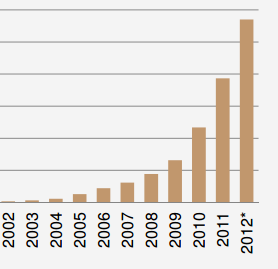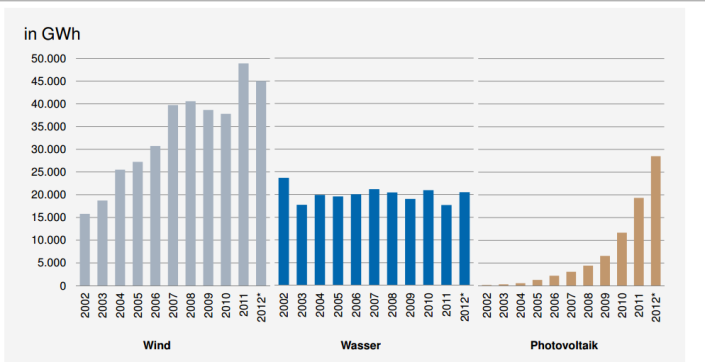renewables
Andrew Simms, energy and green herrings
Andrew Simms of The New Economics Foundation has a book out: Cancel The Apocalypse. He appears to have a large number of apocalypses, and mini-apocalypses, in mind, but I’ll just stick to what he says we should do about climate change. What we discover here is a rather long list of green herrings, that is red herrings with a Green tint. Read the rest of this entry »
Fact Check: Comparing wind and nuclear power
Climate Scientist Kevin Anderson has criticised claims made by Sue Ion, a former technical director of British Nuclear Fuels, made on the BBC. Anderson makes the following quite strongly worded criticism of Ion:
Early on in the programme Sue emphasised how she is committed “to try and do more to help get facts across as opposed to just let the media run with whatever they thought … sometimes stories run when they actually do have no foundation in fact”.
Certainly the world of energy and climate change is awash with educated eloquence trumping quantitative analysis – and any attempt to rescue the latter from the former has to be welcomed.
However, despite Sue Ion’s concern about energy stories often having “no foundation in fact”,when it came to drawing comparisons between electricity generation from nuclear and wind power her comments only added to the misinformation that pervades energy debates.
Sue Ion suggests 1500 offshore wind turbines generate the same electricity as one nuclear power station; the real number is much lower – somewhere between 250 and 600.
So, Ion apparently had a figure that is three times higher than it should be. The comments by Ion can be heard about 20 minutes in. [Update: in the comments section David has pointed out that Anderson has misunderstood what Ion was referring to. The question asked to her was in relation to a “nuclear power station,” not an individual reactor. Historically nuclear power stations in the UK have had two reactors, in France they often have four. The new nuclear power stations planned for the UK have more than 1 reactor, so this presumably is what Ion has in mind. So, Anderson should really be multiply his nuclear GW by 2.]
Below is the argument Anderson uses to counter Ion’s claim:
Calculations and Assumptions
The following calculations are premised on proposals for new-nuclear build,
assuming full operation by 2020 and assuming the load factor is significantly
improved from the UK’s experience of operating nuclear stations. The figures for
wind turbines similarly are premised on appropriately sited designs, with a good
capacity factor and assuming turbines at sizes equivalent to the larger models
now being installed and those likely to be installed before 2020.
NUCLEAR
Three reactor designs are now being considered for UK new-build.
§ Areva’s EPR – with a capacity of 1.6GW
§ Westinghouse’s AP1000 – with a capacity of 1.15GW
§ Hitachi-GE’s Advanced Boiling Water Reactor – with a capacity of 1.3GW
Assume an 85% load factor for all the nuclear designs
Note: this is 5% higher than is sometimes suggested should be the starting value
for nuclear load factors, and is 25 percentage points above the mean UK load
factor for nuclear power between 2007 ad 2011 (i.e. 60.1%).
WIND
Currently, installation of 6MW turbines is proceeding, with 8MW designs planned for
installation by ~2014, heading towards 10MW within a few more years. Some
companies are already proposing designs of up to 15MW per turbine. For comparing
with the nuclear designs operational by 2020, these calculations assume 6 to 10MW
turbine designs.
Assume a conservative capacity factor of 40% for offshore wind turbines.
For a well-sited large and offshore turbine, a 40% capacity factor is not
unreasonable figure to assume. It is worth noting, asthe capacity (MW per turbine)
increases, so does the hub height and hence the typical capacity factor. Moreover,
if sited off the West coast of the UK the capacity factor is likely to be higher still.
COMPARISON
The three nuclear designs with a 85% load factor would generate between 8.6TWh and
11.9TWh each year
A 6MW and 10MW wind turbine with a 40% capacity factor would generate 21GWh
and 35GWh/year respectively.
Consequently, between 244 and 567 turbines are required to generate the same
quantity of electricity in a year as the three proposed new-nuclear designs
Who is correct?
Sadly, it appears that while Anderson is probably correct that Ion is making an inaccurate claim, he is also doing exactly what he has criticized Ion for doing, by correcting misleading information with misleading information.
First, consider that he uses turbine capacity of at least 6 MW. A quick look at Wikipedia will tell you that the average for existing UK offshore wind farms is slightly below 3.6 MW, with most wind farms using a 3.6 MW turbine. You can also see that 3.6 MW turbines predominate in the offshore wind farms that are currently being constructed. Ion’s remarks appear to clearly relate to existing wind farms, so exactly why Anderson is using a turbine capacity this large is unclear.
Anderson also claims that a 40% capacity factor for offshore wind farms is conservative. This may or may not be true for new offshore wind farms with 6 or 10 MW turbines, however for existing offshore wind farms it appears to be too high. Historic offshore wind farm capacity factors can be found from the UK government’s Department for Energy and Climate Change. These have been around 33-35% over the last few years.
So, let’s rephrase Ion’s claim and ask how many 3.6 MW turbines, at the UK average capacity factor of 35%, would provide as much electricity as a modern nuclear power plant. To get the same power as the 1.6 GW would take about 1,100 turbines. Matching Hitachi’s 1.3 GW reactor would take about 880 turbines.
What we are looking at is one of those rare occasions where the truth lies somewhere in between, and another example of people using numbers to make a point, and not to inform. [though I’ll now take back my comment about the truth lying somewhere in between, as Ion seems to have produced very reasonable numbers given that she was actually referring to a nuclear power station.]
Is German solar power growing too fast?
Mark Lynas has posted a good, quick summary of the status of Germany’s Energiewende. Like me he does not believe the Energiewende is doing a great deal to reduce emissions. However, his assessment of German solar power is perhaps more generous than it should be:
Solar continued its enormous growth rate between 2011 and 2012. Production rose from 19.3TWh (terawatt-hours) in 2011 to 27.6TWh in 2012, representing an impressive increase of 47.7%. In terms of total electricity generation, solar’s percentage rose from 3.2% in 2011 to 4.6% in 2012. This is an extraordinary achievement by any standard.
I will agree that, looked at in isolation, the growth in German solar power is impressive. You may even be inclined to throw around words such as exponential growth to describe what has happened in the last decade:
Growth in solar power however does not occur in isolation. Money spent subsidizing solar is money not spent subsidizing something else, in particular wind. We can argue about the details, but I don’t think there is any real reason to not believe that onshore wind is a) a lot cheaper than solar and b) can provide a much higher percentage of Germany’s electricity supply. These two basic facts, and common sense, would indicate that Germany should be expanding wind much faster than solar. Instead the opposite is happening:
Remarkably wind production was only 15 GWh higher in 2012 than 2007, whereas production from solar was up about 20 GWh. Lower wind conditions may have pushed wind farm output below average, but it is clear that in the last half decade solar has grown faster than wind power. This should be seen as a complete misuse use of vital money, but instead Germany’s rapid growth in solar is regularly touted as an example worth following.
So, here we have an example of a government “picking winners,” but clearly not doing a very job of it.
(Thanks to Gustaf Rossell for pointing me to the data referenced above)
Greenpeace and Arithmetic
Greenpeace and other environmental groups have recently expended a great deal of energy trying to get the UK to commit to de-carbonizing the UK electricity grid by 2030. This hoped for target was for, on average, 50 g CO2 to be produced per kWh of electricity, which the government has decided to not include in its energy bill.
Instead of going over the debate over whether a target is a good idea, let’s instead consider whether the government would be wise to follow Greenpeace’s overall policy prescriptions. I’ll simplify these to three policies: the UK has a legally binding target of 50 gCO2 /kWh for electricity, no nuclear power plants, and no CCS power plants by 2030. So, how do we get to 50 g CO2/kWh in such a scenario? Read the rest of this entry »
Germany’s Lost Decade
Germany appears intent on doing three things faster than almost any developed country: expanding renewable power, closing nuclear power plants, and building new coal power plants. The first two are much praised by those who drink the Energiewende Kool Aid, while the third is often treated as some kind of myth by the same people. Germany’s Environment Minister however recognizes it is not a myth, but appears to believe in magic instead. After the opening of 2.2 GW coal power plant earlier this year, he absurdly stated the following:
“If one builds a new state-of-the-art lignite power plant to replace several older and much less efficient plants, then I feel this should also be acknowledged as a contribution to our climate protection efforts.”
Now, one would have hoped that such statements would kill off Germany’s hopes of being a model Green country. Read the rest of this entry »
France’s 2025 nuclear target
The current French government supposedly have plans to go from 75% to 50% nuclear by 2025. The fact that the reduction is 25% should instantly raise a skeptical eyebrow. Such things are almost always driven by politics, and not solid economics (a fine example is the EU’s 2020 target of 20% renewables, 20% emissions cuts, and 20% energy efficiency all by 2020, well pilloried by Dieter Helm in The Carbon Crunch.)

